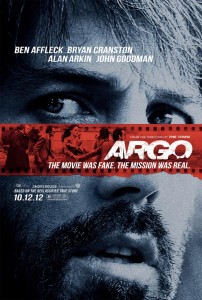 Not only do the Americans save the day in the fact-based new movie “Argo,” but they do it without firing a shot or dropping a bomb.
Not only do the Americans save the day in the fact-based new movie “Argo,” but they do it without firing a shot or dropping a bomb.
At the start of the Iranian hostage crisis in 1979 when revolutionaries stormed the American embassy and took 52 people hostage, six U.S. diplomats managed to escape the embassy before the revolutionaries took over. They found a safe haven in the home of Canadian ambassador Ken Taylor (Victor Garber) who risked his own life by taking them in and hiding them. The CIA finds out about the hidden diplomats and knows that if they’re discovered, everyone involved will be executed in the streets. So how can they get them out of Iran?
Exfiltration expert Tony Mendez (Ben Affleck) offers the best of a group of bad ideas: join forces with Hollywood to come up with a cover story that the six Americans are actually a Canadian film crew location scouting Iran for a ridiculous science fiction movie called “Argo.”
Mendez will fly into Iran with fake passports and backstories for the six diplomats, then teach them their cover stories. All of them would then pretend they’re a film crew while walking past the airport security checkpoints – including past the brutal Iranian Revolutionary Guard – and fly out of the country on a Swiss Air flight. If it weren’t a true story, it would be one of the most far-fetched plots you’ve ever heard.
“Argo” works on a number of levels. The angry Iranian crowds who storm the American embassy are eerily reminiscent of news footage from the Middle East that we’ve all seen in recent days. Through some opening narration, the film provides the political lead-up to the incident, including some bad decisions made by the United States in the previous 30 years. The Americans are the good guys here as well as the victims, but the film acknowledges there’s a dark complexity to our political history.
“Argo” then veers into some unexpected comic relief as Mendez heads to Hollywood to work out the specifics of developing a fake movie that will save people’s lives. Playing his two primary cohorts are John Goodman as Hollywood makeup artist John Chambers – and Alan Arkin as producer Lester Spiegel, who insists that if he’s going to make a fake movie, it’s going to be a fake hit.
Some of the film’s best lines (though be forewarned, they tend to be profanity-laced) come from Goodman and Arkin, who both embody and mock the illusion-based nature of Hollywood. For instance, in order for the “Argo” cover story to be as real as possible so that the Iranians buy it, they need to get publicity for their fake movie. As one of them says, “The best way to sell a lie is to get the press to sell it for you” (not exactly a great endorsement for susceptible members of the news media). They stage a public reading of the movie script that is covered by the press, and also take out an ad in Variety promoting the film – a decision that will have repercussions later on.
At the same time, these two Hollywood veterans actually care about the lives of the people in crisis and the state of the country. At one point, as Arkin is watching stories on the news about America in crisis around the world, he laments, “John Wayne’s in the ground six months and this is what’s left of America.” That line seems to express nostalgia for a simpler time – though in reality, no era was particularly simple.
Finally, “Argo” moves to Iran as the plan is executed. Affleck, who directed the film as well as starred in it, does a masterful job of creating a steady stream of tension that just keeps building and building. I think my heart was pounding constantly for the film’s final 45 minutes. Though the six diplomats aren’t particularly well-developed as characters, the precariousness of their situation and little quirks developed throughout are enough to keep you invested in what happens to them.
Affleck’s attention to 1970’s era detail, all the way down to the old Time Warner logo at the start of the film, is also a feather in his cap. It may be an unintentional homage to “Star Wars” which is referenced during the movie, but I liked the fact that the six diplomats once had to hide in a secret compartment in the floor of the ambassador’s house to escape discovery. That’s what Luke, Han and the crew did when the Millennium Falcon was tractor-beamed into the Death Star. Yes, I know it’s a stretch, but it’s my blog post and I’ll stretch if I want to.
As I mentioned at the start of this review, “Argo” is impressive in that this is a heroic story in which the heroes don’t shoot or kill anybody. I’m not averse to action scenes in a movie, but in many cases, the violence is covering up a lack of story. One of the trailers before “Argo” was for another film called “Gangster Squad” which annoyed me with its seemingly mindless, glorified violence. In “Argo,” the characters are forced to be wise as serpents to save lives. There’s a genuine sense of danger pervading the movie, but the heroes have to use brains and skills in the midst of fear to get out of it.
If you’re looking for a riveting piece of American history that, in its own way, is an old-fashioned story of heroism, give “Argo” a try. It demonstrates that knowing how a movie ends doesn’t have to lessen the tension along the way.
(You can also read Steven Greydanus’ review here.)












